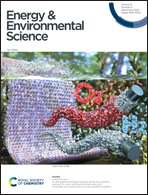Design strategies for markedly enhancing energy efficiency in the electrocatalytic CO2 reduction reaction
Abstract
The electrocatalytic CO2 reduction reaction (CO2RR) offers a promising approach to ameliorate global warming and the energy crisis. On the route to deploying this technology, tremendous efforts have been dedicated to designing remarkable electrocatalysts and electrolysis systems. While the performance indicators of the CO2RR such as current density and faradaic efficiency are well researched, the energy efficiency (EE), a guiding metric for industrial implementation and economic feasibility of the CO2RR, should merit more deliberation. In this context, our review aims at providing a comprehensive understanding of full-cell EE of the CO2RR. First, the fundamental principles towards achieving high EE in the CO2RR are presented. Subsequently, recent state-of-the-art strategies for kinetically boosting EE are elaborated, with focus on electrocatalysts and system design to lower the cell voltage and increase faradaic efficiency. In particular, the emerging integrated electrolysis is highlighted, where the conventional anodic oxygen evolution reaction (OER) is replaced with other value-added oxidation reactions, affording great promise to enhance the EE and economic benefits of the CO2RR. Finally, future research opportunities in this rapidly evolving field are outlined. This review would attract considerable attention to full-cell EE and further inspire investigation into increasing EE at a commercially relevant current density to motivate the scale-up of the CO2RR.



 Please wait while we load your content...
Please wait while we load your content...